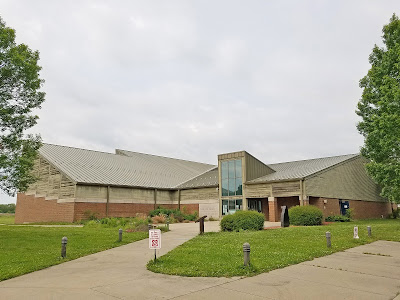Sunday, May 16, 2021
Started the day in Hartford, IL.
 |
| Driving on a levee of the Mississippi River |
 |
Looking up the Mississippi towards the
confluence with the Missouri River |
 |
| Hope this four-leaf clover brings us luck! |
*On 12/12/1803, William Clark arrived with the crew at the site where they would set up Camp River Dubois as their winter quarters. The expedition would not begin until the Louisiana Territory was officially transferred to the United States.* |
| Lewis & Clark Historical Marker |
 |
The replica Camp River Dubois is located across from
the mouth of the Missouri River, but because the rivers
have altered their courses, it is actually 6 miles south of
the now inaccessible original location across the Missouri!
|
 |
| Replica 19C settler's cabin (KSS) |
 |
An amazing true to scale "replica" of the
55-foot long keelboat used by the Corps of Discovery |
 |
"Replica" is in quotation marks, because it
is actually half a keelboat, the cutaway shows
how much cargo they were able to pack |
 |
Also we were able to see some of what the
cargo included, from rifles and ammunition;
metal items to trade such as knives, pails, buttons,
and thimbles; food provisions like salted pork
and whiskey, blankets and clothing, etc |
 |
Don't forget the Peace Medals, with a relief of President
Thomas Jefferson, to gift to chiefs of the First Peoples |
 |
Although the keelboat had a sail, the boat was
usually propelled by long oars set in oar locks |
 |
Every soldier brought his dress uniform
and work uniform; whenever the Corps
was to encounter local tribes,
they dressed up for the occasion! |
 |
Here is everything each soldier had in his kit
(plus those uniforms!) |
*Meriwether Lewis and William Clark attended the ceremonies of the transfer of the Louisiana Territory, from Spain to France on 3/9/1804, then from France to the United States on 3/10/1804.*
*On 5/14/1804, the William Clark with the Corps of Discovery Expedition departed Camp River Dubois.*
We stopped at Lewis & Clark Community College (est 1970) in Godfrey, IL, which purchased grounds, buildings and faculty from the former Monticello College, a female seminary founded in 1835.
 |
A beautiful campus with sculptures,
this is Bloom (2006, by John Medwedeff) |
 |
| Quandary (1998, by John Edgcomb) |
 |
Sacagawea & Jean Baptiste (2002, by
Glenna Goodacre, who also designed the
image on the one-dollar Sacagawea coin) |
 |
| Profile of Sacagawea, with baby Jean-Baptiste |
 |
| Five Walking Figures (2010, by Magdalena Abakanowicz) |
 |
Benjamin Godfrey Memorial Chapel (1854,
in New England Greek Revival style) |
 |
| Lewis & Clark Community College general view (KSS) |
 |
| Spirit of Survival (1998, by Ruth Duckworth) |
 |
| Crossroads Group (2006, by Richard Hunt) |
 |
| New Heritage (1969, by Hillis Arnold) |
 |
| The Bosque (Spanish for a grove of trees) |
 |
Winged Figure Ascending (2012,
by Stephen De Staebler) |
 |
| The Tuning Fork Tree |
 |
Clark Bridge (1994, by Hansen Engineers) crosses the
Mississippi River between IL and MO |
*On 5/14/1804, the Corps of Discovery camped on an island near a bluff 20 miles north of St Louis, and William Clark recommended that a fort be constructed on the bluff.*
*On 9/22/1806, on the return trip, the Corps of Discovery stayed at the newly constructed fort 20 miles north of St Louis.*
 |
Site of Fort Belle Fontaine (built in 1805 on the
recommendation of William Clark, the first United States
military fort built west of the Mississippi River) |
 |
Staircase built in the 1930s by the
Works Progress Administration/WPA |
 |
| Lewis & Clark Campsite Historical Markers |
*On 5/16/1804, the Corps of Discovery arrived in St Charles to pick up more provisions and supplies.* |
Tamiko with a version of Seaman, the
Newfoundland belonging to Meriwether Lewis,
at the Lewis & Clark Boat House (KSS) |
 |
1,804 Oak Leaves (by Kuhlmann Leavitt, Inc)
is based on the year that the actual Corps of
Discovery Expedition began |
 |
The Nature Center cum Museum displayed
items Meriwether Lewis would have taken
on the expedition, including a razor that
may have actually belonged to him |
 |
A series of dioramas quickly summarized the entire trip;
here they are leaving St Charles with an escort |
 |
Fort Mandan, where the Corps of Discovery
spent the winter of 1804-1805 |
 |
The incident where the white pirogue nearly capsizes, and
Sakagawea is the one to rescue important papers and medicines |
 |
| The portage at Great Falls |
 |
Fort Clatsop on the Pacific Ocean,
where they spend the winter of 1805-1806 |
 |
The First Peoples taught the Corps how to build
Bullboats, using the hide of one bison bull |
 |
| A display of what the medicine kit would contain |
 |
A typical campsite, which the Corps of Discovery
would have to set up each time they stopped |
 |
On the window sill are models of the three boats used by the
Corps of Discovery during the expedition, on the right
is the 55-foot keelboat, in the center is the 41-foot red
pirogue, and on the left is the 39-foot white pirogue (KSS) |
Full-size replicas of the three boats were stored on the lowest floor of the boat house, but were not easily viewed. In season, the boats are usually out on the river.
Next: St Charles, MO II.












































No comments:
Post a Comment